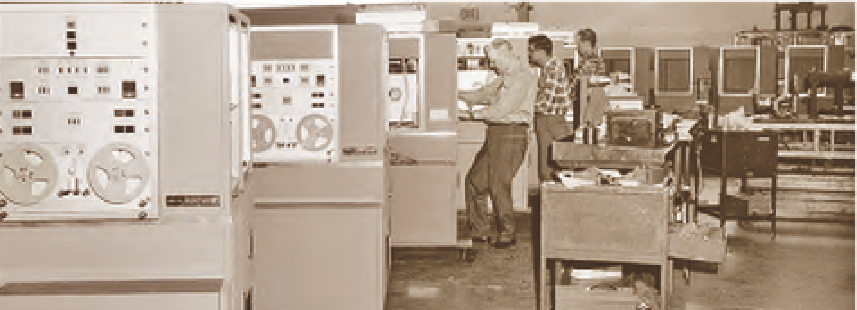Graphics Reference
In-Depth Information
Early phototypesetting systems used a special
keyboard to code punched paper tape that
was fed into the phototypesetter to control the
typesetting process. Paper-tape systems were
replaced by magnetic tape systems and then
by magnetic disks and diskettes.
A newer generation of photo-scanning
typesetters replaced the photo-optical systems
with an electronic system. Fonts are stored as
electronic data. These digitized characters are
projected as typeset text on a cathode ray tube
(CRT) screen. A lens focuses the type on the
CRT screen onto light-sensitive film or paper.
A full page of type, including many different
sizes and typefaces, can be divided into a grid
of several blocks, each the size of the CRT
screen, and stored in the computer's memory.
Photo-scanning typesetters are much faster
than photo-optical systems. They reproduce
sections of the page rapidly, one block at a
time, setting up to ten thousand characters per
second.
Phototypesetters are flexible and fast,
compared to hot-metal typesetting machines,
which could set only about five characters
per second. Hot-metal machines had many
mechanical parts, while phototypesetters were
operated electronically. Photo type needs
little storage space because it is stored on
flat photographic paper or film, while metal
slugs are very heavy and require enormous
amounts of storage space. Phototypesetting
permits electronic editing, with corrections
and changes made at the keyboard.
Phototypesetting freed designers from the
physical restrictions of metal type. Increased
flexibility in spacing typographic elements
included greater control over kerning,
interletter and interline spacing, overlapping,
and special effects such as runarounds (type
running around elements such as images).
Designers who understood the potential of
this technology used it to great advantage.
.....................
.....................
.....................
.....................
......................
.....................
.....................
.......................
..............
..............
..............
7-16
Components
of a typical keyboard
phototypesetter.
..............
.................................
7-15
A keyboard phototypesetter.













